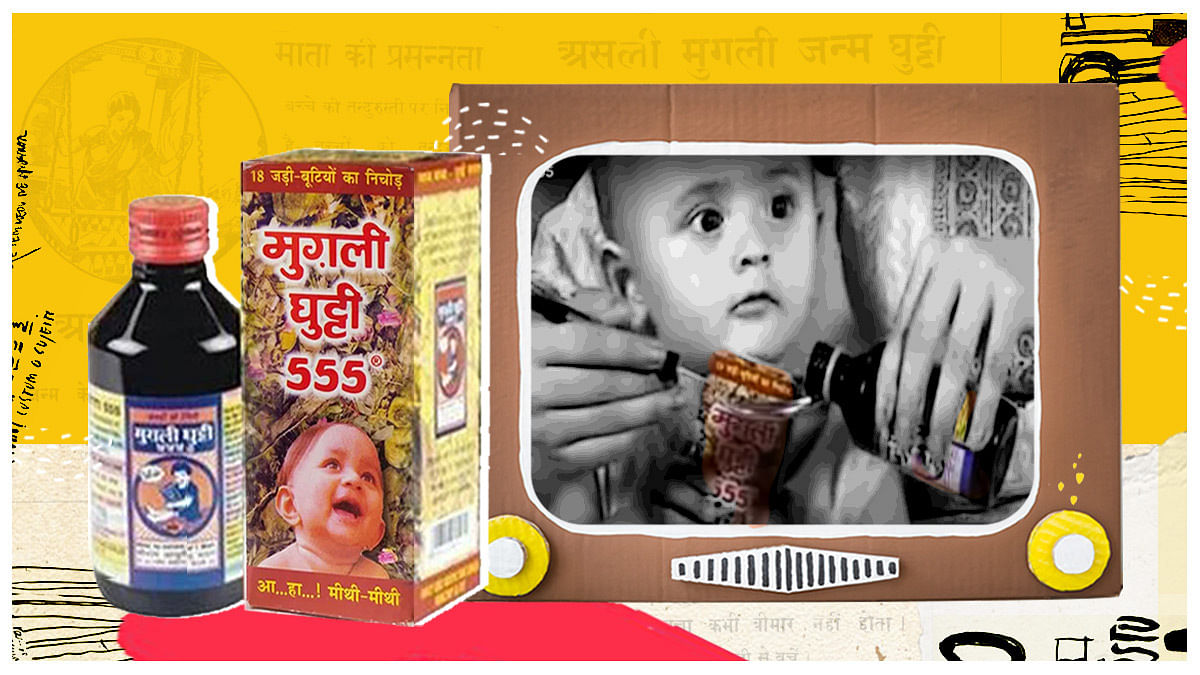Read also : Depauls cold coffee has been Delhi’s favorite since 1952. SRK used to hang out here
Local success
The story of Mugli Ghutti 555 began in 1918 when a self-taught practitioner of Ayurvedic medicine, Lala Shri Ram Arora, was experimenting with various herbs and condiments to make traditional medicines. His home ghaav nashak, an ointment for wounds, was renowned for its rapid healing properties. So, people from his neighborhood in Paharganj would rush to his home clinic in case of sports-related injuries. ArorashomemadeDant Manjanor tooth powder was known to cure bleeding gums and strengthen weak teeth. But more than any other medicine, it was hismugli guttia watery syrup made from cumin seed extract, turmeric, carom seeds, rose extract and many other ingredients that have been shown to be effective against crankiness, flatulence and indigestion in young children .
My great grandfather, Lala Shri Ram Arora, had a God-given gift of healing and he used it for the well-being of people. There was no commercial aspect to his business. It was a purely charitable endeavor. Therefore, when his son Vaid Radha Krishan Arora formalized the business, he named it Shri Ram Ayurved Bhavanto to celebrate the spirit of community welfare, Kathpalia.
From cottage industry to big brand
During the first five decades of its existence, when Shri Ram Arora, his son Radha Krishna Arora and his two grandsons Gopal Krishan Arora and Sudhir Arora were running the company, Shri Ram Ayurved Bhavan was a family business. The joint family and its various branches lived on the ground floor and the factory functioned on the first floor and the terrace. When we lived in Paharganj, it was truly old Delhifamily system. I remember, as a child, raw materials being delivered down the aisle by the pace of old three-wheeled vehicles. The broilers worked all day. says Kathpalia, thinking of the days when the brand was run as a small cottage industry. She says she clearly remembers the aroma of the 18 to 20 herbs that were left to dry on her large deck.
The business was so intimate that during summer vacations, children were allowed to sit in the large storage room and fold sheets of cardboard into packing boxes. Such activities allowed the next generation to immerse themselves in the business. The founders had a very clear idea of how they wanted to run this company. There was no external financing, no loans, no outsourcing of work, no excessive spending on major infrastructure. Everything was done under the supervision of directors, all from the family, adds Kathpalia.
Whatever profit the business generated was put back into the business. This is how it remained debt-free and gradually grew in size.
In the early 1970s, when brothers Gopal Krishan and Sudhir Arora started running the company, they realized that once there was sufficient liquidity within the company and the brand had become well known in the northern India, the time was ideal to develop the activity. The first objective of the mission was to increase demand. And that required more aggressive marketing and advertising. Even though my father and uncle had no formal training in business management or communications, they knew very well who their customers were and what type of marketing was needed, Kathpalia says.
Apart from an iconic radio jingle, Gopal Krishan and Sudhir Arora used simple but effective tools to reach out to their target audience, the middle and lower classes.
The founders asked satirist and comedian Kaka Hathrasi to produce a light-hearted chat show calledMitthi Mitthi Hasaaiyaan, broadcast weekly on All India Radio. They set up eye-catching booths at local fairs in towns and small villages to attract families with young children. Innovative toys were designed and produced to be distributed at the stands, such as Snake and Ladder boards, Ludo, playing cards and cups with company insignia. These were widely distributed among the visitors to the Mela. All of these interventions led to increased sales and an even bigger brand. By the late 1980s, Mugli Ghutti 555 and many other products from Shri Ram Ayurved Bhavan were competing neck and neck with more established Ayurvedic brands such as Baidyanath and Dabur.
The current directors of the company are Sudhir Arora and Vikas Arora.
Founders Gopal Krishan and Sudhir Arora turned a disadvantage into a strength. There is an inherent suspicion among Indians of a large corporatized medical system and a traditional faith in small, intimate medical systems.Vaidya-headed family produced Ayurvedic formulations. Removing this factor became the main reason for the success of Mugli Ghutti, says Kathpalia.
This article is part of a series called BusinessHistories exploring iconic businesses in India that have navigated challenging times and changing markets. Read all articles here.
View full article
#Mugli #Ghutti #local #brand #Paharganj #challenged #Baidyanath #Dabur
Image Source : theprint.in

